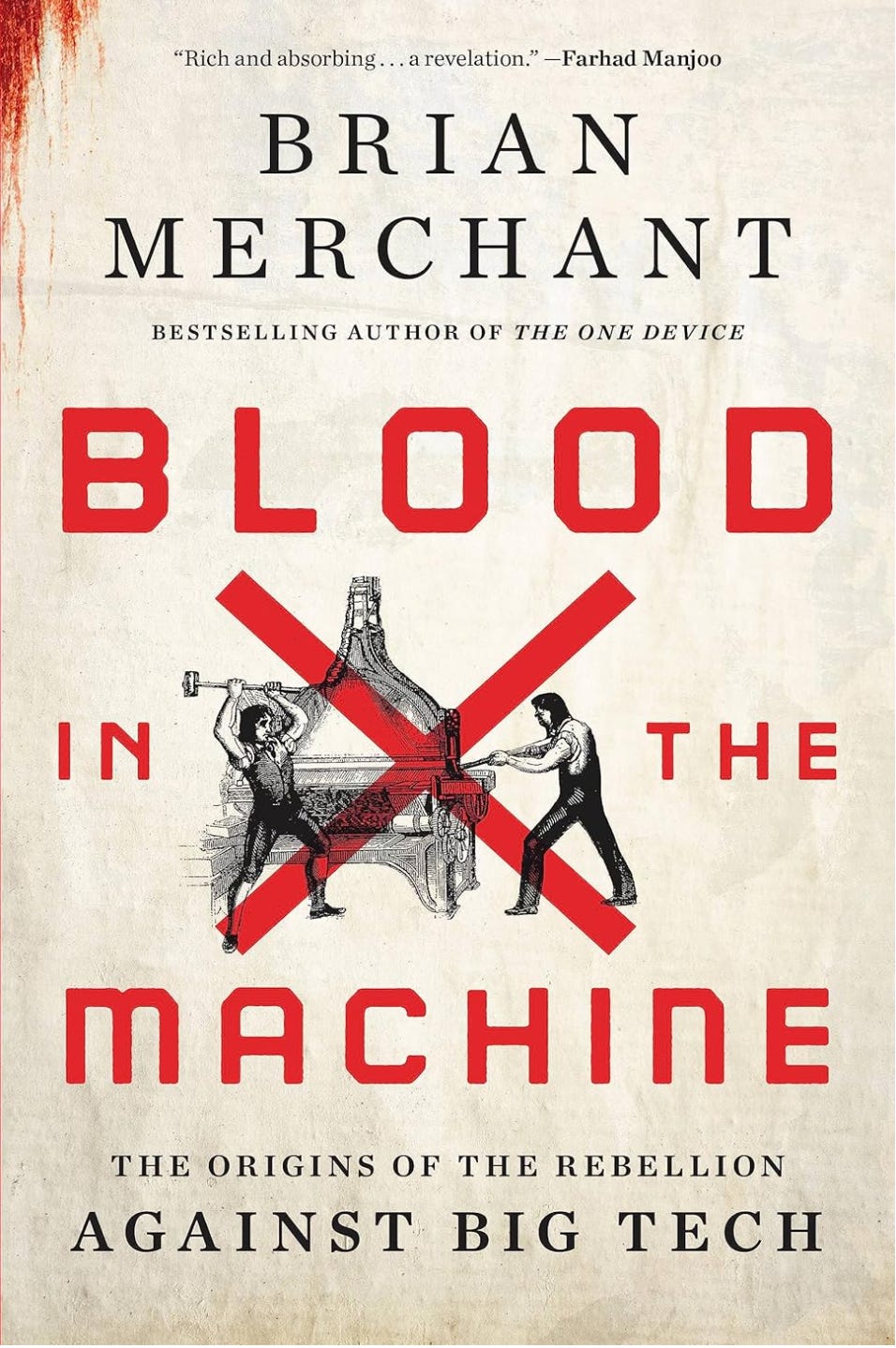What a Public Execution in 1813 Tells Us About AI Today
The Luddites weren’t anti-technology, they were anti-poverty. Their story has a warning for the AI age.
This week, we’re talking:
In 1813, the state hanged 17 Luddites to make an example of workers who dared fight a system rigged for the owners. Today, AI’s disrupting jobs 10x faster—and once again, the rich are hoarding the gains while everyone else faces the axe. This time, the fallout could be bigger, faster, and harder to stop. ⚠️🪓🤖💥
The Fed’s flying blind, economists are scouring fast-food receipts, and the data says nothing’s wrong — yet. Welcome to the vibes-based recession. 💸📉🕵️♂️🔮
Reality’s breaking down, the internet’s speeding up, and AI’s waiting to catch what’s left of you: Jia Tolentino’s New Yorker essay is a haunting diagnosis of life inside the glitch. 🫠📱🤖🌀
A chess study reveals we cling to familiar moves, even when the game’s rules change. Sound familiar? Turns out winning in chaos means unlearning the old playbook. ♟️🌀 🧠
Humans have seen less of Earth’s deep seafloor than the surface of Mars. What’s lurking down there? 🌊🚀👀
Jenkins ran his ecstasy business like a Silicon Valley startup: vertical integration, product innovation, guerrilla marketing, and an eye on market expansion. 📈💼⚡️
Mexico’s Claudia Sheinbaum is charting a new path for industrial policy—one where the government doesn’t just incentivize growth, but actively builds it. What can U.S. policymakers learn from “Plan Mexico”? 🚗🔋🌎
My Take:
On January 8 and 16, 1813, York Castle became a grim theater of state violence. The scaffold was dragged into the icy courtyard twice that month, and over two waves, 17 Luddites—most convicted not of murder but of smashing machinery—were hanged in front of massive crowds. Soldiers stood guard as church bells tolled; families clutched each other in the cold as neighbors, husbands, and fathers were led to their deaths. While a handful were sentenced for killing a mill owner, the vast majority were executed for property crimes under the Frame Breaking Act, which made machine-breaking a capital offense. Publicly executing the Luddites was a brutal pageant of control, a public warning that the price of vandalizing the new machines was death.
The term “Luddite” is variously traced to Ned Ludd, a textile worker said to have smashed a knitting frame in 1779, or to King Ludeca, a ninth-century Anglo-Saxon ruler slain in battle. Regardless of origin, many machine-breakers rallied under the name “General Ludd.”
This is where history does the Luddites dirty: we remember them as backward-looking, anti-technology reactionaries, but that’s not the full story.
They weren’t fringe outlaws; they were community men pushed to the edge by collapsing livelihoods and rising desperation. The introduction of mechanized looms caused a seismic shock to the industry: in just a few years, the number of stocking knitters collapsed from around 240,000 to 60,000. It was a 75% wipeout in less than a decade, a brutal freefall that decimated entire communities.
This is where history does the Luddites dirty: we remember them as backward-looking, anti-technology reactionaries, but that’s not the full story. They were skilled workers furious not at machines themselves, but at how those machines undercut wages, erased livelihoods, and pushed their families into ruin. Their rebellion wasn’t about fear of progress; it was fear of poverty, of watching their families starve while the owners of the new machines got rich—a fight crushed by a legal system that put capital above people, a dynamic we still live with today in a world where money equals speech, and speech equals power.
Now? We’re hurtling into an AI revolution that’s moving 10–20x faster than anything the Luddites faced. Where it took mechanized looms decades to upend an industry, AI is transforming entire sectors in just a few years.
And this time, the stakes are even higher.
AI isn’t just automating grunt work—it’s gunning for high-skill jobs: lawyers, bankers, software engineers, healthcare providers. Legal AI drafts entire deal docs. Investment AI replaces analyst teams before lunch. Zuckerberg has openly said Meta will swap mid-level engineers for AI. Nurses and frontline care workers? They’re on deck.
If we don’t design AI—and the economic policies around it—with the workforce in mind, we’re not innovating. We’re detonating.
AI will transform work, and much of it for good. But when there’s no serious thought about the people in that workforce, when the richest and most powerful hoard the gains while dumping the downsides—like job loss, wage cuts, and economic instability—onto everyone else, the result is as predictable as it is ugly: mass disruption, deepened inequality, and social unrest.
At super{set}, our company Checksum built AI that boosts productivity by automating testing and QA through AI —but we keep humans in the loop. The AI at Checksum is augmented intelligence that makes software developers faster, smarter, better. Tools should make people stronger, not obsolete.
If we don’t design AI—and the economic policies around it—with the workforce in mind, we’re not innovating. We’re detonating. We need guardrails: strong labor protections, serious investment in retraining and upskilling, sensible government regulations, incentives for augmentation-first tech, and accountability for companies that profit from displacement without reinvestment.
We’ve been here before. The tools get shinier. The playbook stays the same.
The A in AI should stand for Augmented. Otherwise, we’re just replaying history with sharper tools and bigger blind spots, and the fallout will be even harder to clean up. We can either build a future where tech lifts all boats—or watch, again, as it drowns the people doing the rowing.
Want to dig deeper into this topic? Here’s some suggested reading:
Rethinking the Luddites in the Age of A.I. by Kyle Chayka via New Yorker
My Media Diet:
Recession Warnings Are Everywhere, Except in the Data By Ben Casselman and Colby Smith via NYTimes 💸📉🕵️♂️🔮
The data says we’re fine. The vibes say we’re doomed. Welcome to the Schrödinger’s Recession, where the official numbers hum along, but CEOs are sweating, economists are doomscrolling freight stats, and the Fed’s flying blind. Blame it on Trump’s tariffs: they’ve jacked up prices, muddied supply chains, and left policymakers combing through McDonald’s receipts and TSA lines like economic conspiracy theorists.
The core dilemma? Everyone’s waiting for the hard data to catch up with the soft signs — but by then, it might be too late. Like the pandemic taught us: the spreadsheets lag, the stories leak first. And this time, the stories don’t agree. Some say inflation will roar, others say demand’s about to crater. Meanwhile, the Fed stands still, afraid to jump while the floor keeps shifting.
In short: if you’re looking for clarity, you won’t find it in a spreadsheet. You’ll find it in the weird little corners of the economy nobody used to bother checking — and even those aren’t telling the same story.
My Brain Finally Broke by Jia Tolentino via The New Yorker 🫠📱🤖🌀
Reality’s broken the fourth wall, and we’re all trapped in the audience. Jia Tolentino’s latest dispatch is a psychic weather report for the brain-fogged, doom-scrolling, unreality-addled masses: we are living inside the glitch. Meaning leaks from words. Facts dissolve into vibes. AI deepfakes, algorithmic distortions, and fascist fever dreams collide in a relentless feed where the horrific, the absurd, and the artificially-generated become indistinguishable—and then instantly disposable.
Trump’s second term doesn’t just erode democracy; it weaponizes the speed of the internet to accelerate decay. We’re past the era of “can he really do that?” outrage and deep into the dissociative shrug of “he already did, and tomorrow will be worse.”
In a world where the phone eats time, fake images supplant real ones, and the grotesque parade keeps marching, the challenge isn’t resisting a particular policy or technology—it’s resisting the urge to opt out of reality altogether.
Chess players rely on familiar moves even when the game changes by Sujata Gupta via Science News ♟️🌀🧠
Turns out we’re all playing life like it’s regular chess—even when the board’s been scrambled beyond recognition. A new study on Chess960 (the variant where the back-row pieces get shuffled) shows that players still cling to familiar opening moves, even when those moves make no sense in the new setup. Call it muscle memory, call it a “memory premium”—either way, it’s a shortcut that works just enough to keep us stuck inside it.
The kicker? Experience chips away at that reliance. The more you play in chaos, the less you cling to old scripts. Legendary chess rebel Bobby Fischer invented Chess960 to force players into true strategic thinking, not memorization—and it turns out, that’s a metaphor for everything. In a world that’s increasingly unpredictable, the real skill isn’t playing the old moves better. It’s learning to stop playing the old game.
Humans still haven't seen 99.999% of the deep seafloor by Nell Greenfieldboyce via NPR 🌊🚀👀
We’ve mapped Mars better than our own oceans—and it’s not even close. A new study reveals that humans have seen just 0.001% of the deep seafloor. That’s about the size of Rhode Island. The rest? A vast, dark, unmapped wilderness teeming with creatures we’ve barely glimpsed and ecosystems we can’t yet imagine.
It’s a humbling reminder that while we throw billions at exploring distant planets, we’re still fumbling in the dark beneath our own waves. And every dive—every flicker of light into that abyss—upends what we thought we knew. Maybe the biggest frontier isn’t “out there” after all. It’s right here, under two-thirds of our planet, waiting.
The King of X by Tom Foster via Texas Monthly 📈💼⚡️
Robert Jenkins isn’t your average retiree living by a Texas river in a busted Blue Bird bus. Once dubbed the “King of X,” he built an ecstasy empire that stretched from Dallas to Paris, from underground raves to high-fashion lofts. He manufactured millions of pills, outran cops, flipped a Paris fashion mag into a drug-smuggling front, and partied with rock stars. His life? Part outlaw, part entrepreneur, part absurdist experiment.
Today? He watches the San Marcos River roll by, more philosopher than kingpin, haunted by the chaos he left in his wake—and quietly proud he never snitched. “I probably got a million people laid,” he quips, “and that’s worth something, right?”
Democrats Could Learn a Lot From Mexico’s Claudia Sheinbaum by Kate Aronoff via The New Republic 🚗🔋🌎
While Democrats flail around in post-Biden chaos, Mexico’s Claudia Sheinbaum is quietly offering a bold, coordinated blueprint for industrial policy. Her administration’s “Plan Mexico” isn’t just about subsidies or incentives—it’s about weaving together state ownership, public-private partnerships, and sector-by-sector planning to build strategic industries from the ground up.
From affordable EVs produced in Mexico to domestic battery production tied directly to a cleaner grid, Sheinbaum’s approach shows what’s possible when government plays an active role in shaping markets, rather than simply reacting to them. Backed by a rare political mandate and growing public trust, her government is using industrial policy as a tool for economic sovereignty, shared prosperity, and long-term resilience.
The lesson? You can’t “message” your way out of inequality. You’ve got to build your way out.




